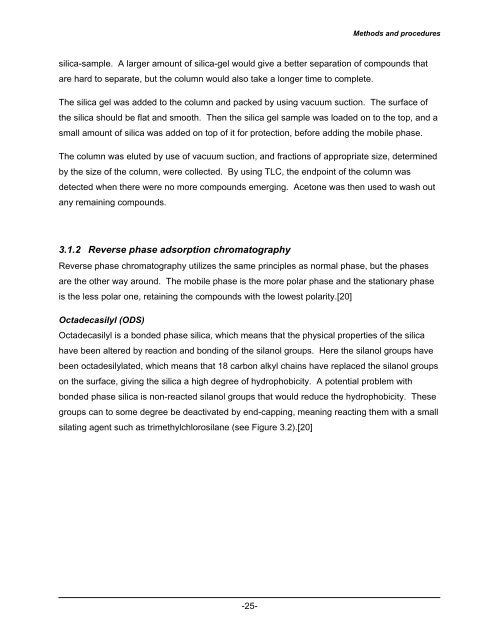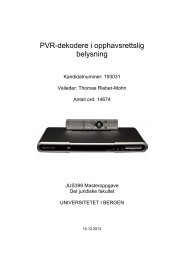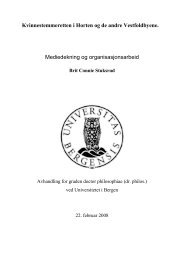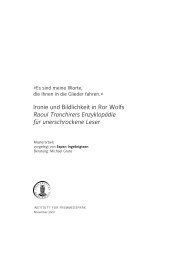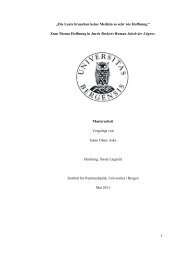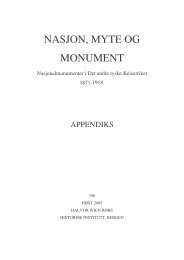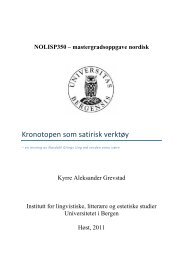Herbal plants used in TCM as a source of compounds with ... - Bora
Herbal plants used in TCM as a source of compounds with ... - Bora
Herbal plants used in TCM as a source of compounds with ... - Bora
Create successful ePaper yourself
Turn your PDF publications into a flip-book with our unique Google optimized e-Paper software.
Methods and proceduressilica-sample. A larger amount <strong>of</strong> silica-gel would give a better separation <strong>of</strong> <strong>compounds</strong> thatare hard to separate, but the column would also take a longer time to complete.The silica gel w<strong>as</strong> added to the column and packed by us<strong>in</strong>g vacuum suction. The surface <strong>of</strong>the silica should be flat and smooth. Then the silica gel sample w<strong>as</strong> loaded on to the top, and <strong>as</strong>mall amount <strong>of</strong> silica w<strong>as</strong> added on top <strong>of</strong> it for protection, before add<strong>in</strong>g the mobile ph<strong>as</strong>e.The column w<strong>as</strong> eluted by use <strong>of</strong> vacuum suction, and fractions <strong>of</strong> appropriate size, determ<strong>in</strong>edby the size <strong>of</strong> the column, were collected. By us<strong>in</strong>g TLC, the endpo<strong>in</strong>t <strong>of</strong> the column w<strong>as</strong>detected when there were no more <strong>compounds</strong> emerg<strong>in</strong>g. Acetone w<strong>as</strong> then <strong>used</strong> to w<strong>as</strong>h outany rema<strong>in</strong><strong>in</strong>g <strong>compounds</strong>.3.1.2 Reverse ph<strong>as</strong>e adsorption chromatographyReverse ph<strong>as</strong>e chromatography utilizes the same pr<strong>in</strong>ciples <strong>as</strong> normal ph<strong>as</strong>e, but the ph<strong>as</strong>esare the other way around. The mobile ph<strong>as</strong>e is the more polar ph<strong>as</strong>e and the stationary ph<strong>as</strong>eis the less polar one, reta<strong>in</strong><strong>in</strong>g the <strong>compounds</strong> <strong>with</strong> the lowest polarity.[20]Octadec<strong>as</strong>ilyl (ODS)Octadec<strong>as</strong>ilyl is a bonded ph<strong>as</strong>e silica, which means that the physical properties <strong>of</strong> the silicahave been altered by reaction and bond<strong>in</strong>g <strong>of</strong> the silanol groups. Here the silanol groups havebeen octadesilylated, which means that 18 carbon alkyl cha<strong>in</strong>s have replaced the silanol groupson the surface, giv<strong>in</strong>g the silica a high degree <strong>of</strong> hydrophobicity. A potential problem <strong>with</strong>bonded ph<strong>as</strong>e silica is non-reacted silanol groups that would reduce the hydrophobicity. Thesegroups can to some degree be deactivated by end-capp<strong>in</strong>g, mean<strong>in</strong>g react<strong>in</strong>g them <strong>with</strong> a smallsilat<strong>in</strong>g agent such <strong>as</strong> trimethylchlorosilane (see Figure 3.2).[20]-25-


